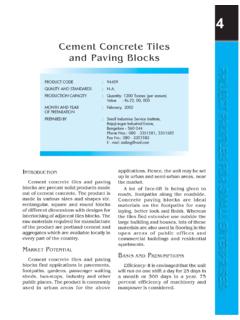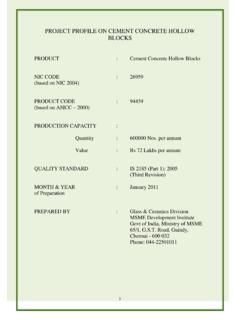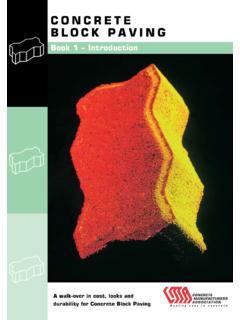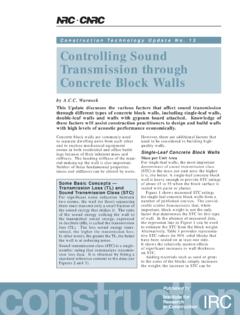Transcription of CoverBlocks Overview General - KK Manhole & Gratings Co ...
1 Draft Cover Blocks Overview 19 July 2011. Client Logo Key Questions I. What are cover blocks? II. Why we must use cover blocks? III. What is the right amount of cover? IV. How to provide the cover effectively? V. How many cover blocks should I use? 1. What are cover blocks? Figure 1: Showing use of cover blocks TMT Bar Cover Blocks Cover Shuttering Cover blocks are used to maintain a specified distance between the TMT rebar and the shuttering 2. Why we must use cover blocks? When doing RCC work it is important to embed the steel in the concrete (also known Figure 2: Showing what happens if cover is not adequate as cover) so that the rebar doesn't corrode and to provide fire protection to the rebar If we don't provide the recommended cover the rebar will corrode with time and will ultimately result in premature failure of the structure (see figure 2).
2 Thus using cover blocks enhances the life of the structure significantly without adding much to the cost Page 3. What is the right amount of cover? The right amount of cover is determined by the application and the environment ( , is the RCC under water, etc.). In normal environments, following are typical covers recommended in the Indian context Application Application Cover Cover (in (in mm). mm). Slab Slab 20. 20 mm mm Beam Beam 25. 25 mm mm Column Column 40. 40 mm mm Foundation Foundation 50. 50 mm mm Page 4. How to provide the cover effectively? Method used to provide cover effectively varies by application KK. KK Fiber Fiber concrete concrete Spacer Spacer Better Better bonding bonding with with surrounding surrounding concrete concrete as as itit is is Application Application Type Type of of Spacer Spacer made made from from the the same same material material Slab Slab KK.
3 KK Fiber Fiber concrete concrete spacer spacer Allows Allows concrete concrete to to flow flow as as Beam Beam -- horizontal horizontal KK. KK Fiber Fiber concrete concrete the the contact contact with with shuttering shuttering is is spacer spacer limited limited Beam Beam Vertical Vertical KK. KK Plastic Plastic Circular Circular KK. KK Plastic Plastic Circular Circular Spacer Spacer For Spacer For sides, use circular sides, Spacer use circular spacer spacer Columns Columns KK. KK Plastic Plastic Circular Circular Even Even ifif the the rebar rebar is is rotated rotated Spacer Spacer the spacing is maintained the spacing is maintained Allows Allows the the concrete concrete to to flow flow through the spacer thus through the spacer thus better better bonding bonding Clips Clips on on the the rebar rebar quickly quickly and and effortlessly effortlessly Page 5.
4 How many cover blocks should I use? Spacer positioning is based primarily on acceptable deflection at maximum loading. Therefore, thinner rebars require more spacers than larger diameter rebars. Below are guidelines for recommended quantities for spacers based on rebar size and application SLABS. Rebar Diameter Maximum Distance Spacers required (per sq-meter). All 70 cm 2. BEAMS & COLUMNS. Spacer Distance In The Longitudinal Direction Rebar Diameter COLUMNS BEAMS. up to 10 mm 50 cm 25 cm 12 to 20 mm 100 cm 50 cm Over 20 mm 125 cm 75 cm Spacer Nos Required In The Transverse Direction Width/Height of Beam/Column COLUMNS BEAMS.
5 Up to 100 cm 2 2. Over 100 cm 3 or more 3 or more Page 6.







